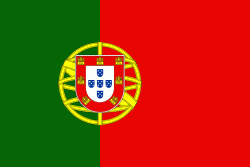Entroncamento
 |
 |
Entroncamento originated in the middle of the 19th century, with the birth of the national railway network, as a simple train-stop, from two small railway construction camps: Casal das Vaginhas and Casal das Gouveias. The majority of the early rail workers/settlers were foreign, coming from different countries throughout Europe, but eventually workers from Beira Baixa and Alentejo moved to the region.
Its toponymic name Entroncamento literally mean junction, owing to being the junction of the two railway lines that developed in 1864: the Linha do Norte (Northern Line) and the Linha do Leste (Eastern Line). Hinged between its links with the east and Beira Baixa, the station at Entroncamento, for many decades, was the obligatory stop that moved goods and people to the north and east. During this time, many celebrated travellers from Europe used the Eastern, dining in the station en route, such as the literary celebrates Hans Christian Andersen, Ramalho Ortigão, Eça de Queiroz, Alberto Pimentel, Luísa de Freitas Lomelino and Eduardo Meneres. Political leaders also became frequent visitors both before and after the 25 April Revolution, such as João Chagas, politician and journalist, who travelled to Lisbon in order to assume the direction of the new government, after the dictatorship of General Pimenta de Castro. For a long time, the two settlements were divided between two neighbouring municipalities, because the rail-line itself determined its boundary. To the west of the lines were the parishes of Santiago (in Torres Novas) and to the east the territory was part of the parish of Nossa Senhora da Assunção da Atalaia (municipality of Vila Nova da Barquinha). The small settlement continued growing, owing to the development of rail transport and support structures, later the installation of military quarters (after 1916) determined the geographic accessibility, resulting in further influx of families.
On August 25, 1926, the settlement was recognised with the status of civil parish. By 1932 Entroncamento was bestowed the urban designation of vila (town) and on November 24, 1945, it was elevated to the status of municipality. Until this date, its route to urban autonomy was a progressive emancipation, first separating from Torres Novas, and later from Barquinha: back then, it was also quite uncommon for a settlement to transform from village to town, then municipality, all within one century. From the small nucleus of families that started to populate the area, the 1930s registered approximately 3000 inhabitants and by 1945 there were 8000 residents. In March 2005, it was estimated the total population included 18,780 residents (calculation based on the number of election-age residents). The growth in the population and expansion resulted in the creation of two new civil parishes: Nossa Senhora de Fátima, to the west of the line, and São João Baptista, to the east.
In the 1950s, Entroncamento was, after Barreiro, the second largest railway centre, with almost half of its national employees. It was estimated that between the 1920s and 1930s, the Entroncamento population associated with the railway operator, CP Caminhos de Ferro Portugueses /Comboios de Portugal exceeded 50% of the local population. CP's corporate social responsibility program included the establishment of urban infrastructures to support its working population by the construction of neighbourhoods, building a school and warehousing, environmental work such as planting vegetation as well as acting as a health center and dispensing anti-tuberculosis drugs to the citizens in need and additionally supporting sport activities. In parallel, the evolution of railway services along with supporting technologies, helped to reinforce the level of education and training, resulting in the creation of teaching centres such as FERNAVE, a subsidiary technical center that also worked in partnership with the Instituto Superior de Transportes (Superior Institute of Transportation).
After the 1970s, changes begun to occur with the gradual substitution of coal-powered steam locomotives to diesel and electric equipment. The introduction of new technologies, brought about the unemployment of some workers, while the subsequent transformation of the company from labour-intensive methods to the newest technology-related services, offered others new opportunities. Lately, while Entroncamento continues to have an elevated number of professionals associated with the rail industry, its economic activities have shifted to commerce and the service sectors as well as industries associated with civil construction. The INE "Instituto Nacional de Estatísticas" statistics for 2004, indicated that Entroncamento continued to be the region with the largest purchasing power in the district of Santarém.
Conscious of its historical underpinnings, on November 24, 2004, the Entroncamento municipal authorities celebrating its anniversary, revised its municipal plan to include the construction of the Museu Nacional Ferroviário Armando Ginestal Machado and the creation of a foundation to manage its affairs, an aspiration that had been proposed in the 1970s. It opened on 18 May 2007.
Map - Entroncamento
Map
Country - Portugal
 |
 |
| Flag of Portugal | |
One of the oldest countries in Europe, its territory has been continuously settled, invaded and fought over since prehistoric times. The territory was first inhabited by pre-Roman and Celtic peoples who had contact with Phoenicians, ancient Greeks and Carthaginians. It was later ruled by the Romans, followed by the invasions of Germanic peoples and the Islamic invasion by the Moors, whose rule was eventually expelled during the Reconquista. Founded first as a county of the Kingdom of León in 868, gained its independence as the Kingdom of Portugal with the Treaty of Zamora in 1143.
Currency / Language
| ISO | Currency | Symbol | Significant figures |
|---|---|---|---|
| EUR | Euro | € | 2 |
| ISO | Language |
|---|---|
| PT | Portuguese language |















